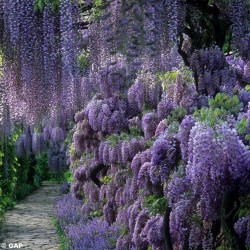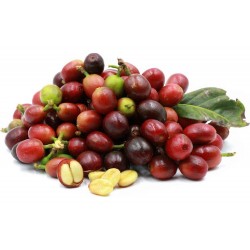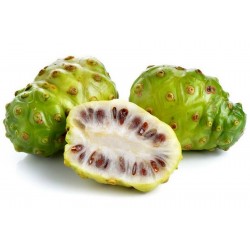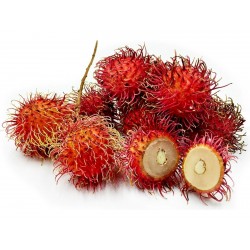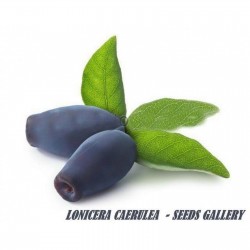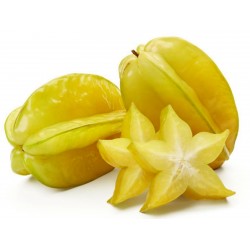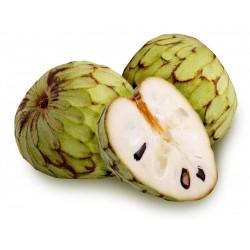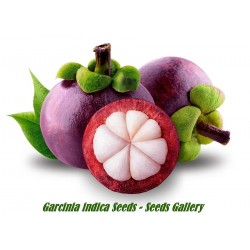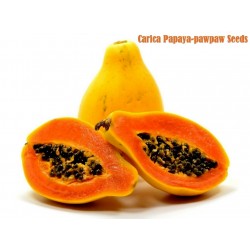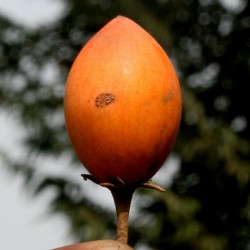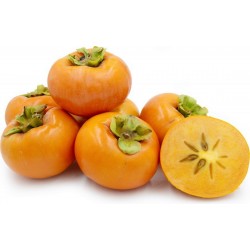Seeds Gallery Com,
5/
5
<h2><strong>Carambola, Star Fruit Seeds (Averrhoa carambola)</strong></h2>
<h2><span style="color: #ff0000;"><strong>Price for Package of 2 seeds.</strong></span></h2>
<p><b>Carambola</b>, also known as<span> </span><b>star fruit</b>, is the fruit of<span> </span><i>Averrhoa carambola</i>, a species of tree native to tropical<span> </span>Southeast Asia.<sup id="cite_ref-jm_1-0" class="reference"></sup><sup id="cite_ref-cabi_2-0" class="reference"></sup><sup id="cite_ref-Gepts_3-0" class="reference"></sup><span> </span>The fruit is commonly consumed throughout<span> </span>Southeast Asia, the<span> </span>South Pacific,<span> </span>Micronesia, parts of<span> </span>East Asia, and<span> </span>the Caribbean.<span> </span>The tree is cultivated throughout tropical areas of the world.<sup id="cite_ref-cabi_2-1" class="reference"></sup></p>
<p>The fruit has distinctive ridges running down its sides (usually 5–6).<span> </span>When cut in cross-section, it resembles a star, giving its name as<span> </span><i>star fruit</i>.<sup id="cite_ref-jm_1-2" class="reference"></sup><sup id="cite_ref-cabi_2-2" class="reference"></sup><span> </span>The entire fruit is edible, usually raw, and may be cooked or made into<span> </span>relishes, preserves,<span> </span>garnish, and juices.</p>
<h2><span class="mw-headline" id="Origins_and_distribution">Origins and distribution</span></h2>
<div class="thumb tright">
<div class="thumbinner"><img alt="Carambola, Star Fruit Seeds (Averrhoa carambola)" src="https://upload.wikimedia.org/wikipedia/commons/thumb/0/06/Carambolas765pt.jpg/220px-Carambolas765pt.jpg" decoding="async" width="220" height="177" class="thumbimage" srcset="//upload.wikimedia.org/wikipedia/commons/thumb/0/06/Carambolas765pt.jpg/330px-Carambolas765pt.jpg 1.5x, //upload.wikimedia.org/wikipedia/commons/thumb/0/06/Carambolas765pt.jpg/440px-Carambolas765pt.jpg 2x" data-file-width="2277" data-file-height="1832" title="Carambola, Star Fruit Seeds (Averrhoa carambola)">
<div class="thumbcaption">
<div class="magnify"></div>
Sliced carambolas having 7, 6, and the usual 5 points</div>
</div>
</div>
<p>The<span> </span>center of diversity<span> </span>and the original range of<span> </span><i>Averrhoa carambola</i><span> </span>is tropical<span> </span>Southeast Asia, where it has been cultivated over centuries.<sup id="cite_ref-jm_1-4" class="reference">[1]</sup><sup id="cite_ref-Gepts_3-1" class="reference">[3]</sup><sup id="cite_ref-Duke_4-0" class="reference">[4]</sup><sup id="cite_ref-Arora_5-0" class="reference">[5]</sup><span> </span>It was introduced to the<span> </span>Indian Subcontinent<span> </span>and<span> </span>Sri Lanka<span> </span>by<span> </span>Austronesian<span> </span>traders, along with ancient Austronesian<span> </span>cultigens<span> </span>like<span> </span>coconuts,<span> </span>langsat,<span> </span>noni, and<span> </span>santol.<sup id="cite_ref-Blench2009_6-0" class="reference">[6]</sup><span> </span>They remain common in those areas and in<span> </span>East Asia<span> </span>and throughout<span> </span>Oceania<span> </span>and the<span> </span>Pacific Islands.<sup id="cite_ref-jm_1-5" class="reference">[1]</sup><sup id="cite_ref-cabi_2-3" class="reference">[2]</sup><span> </span>They are cultivated commercially in<span> </span>India, Southeast Asia, southern<span> </span>China,<span> </span>Taiwan, and the southern<span> </span>United States. They are also grown in<span> </span>Central America,<span> </span>South America, the<span> </span>Southwestern United States<span> </span>and<span> </span>Florida,<span> </span>the Caribbean, and parts of<span> </span>Africa.<sup id="cite_ref-jm_1-6" class="reference">[1]</sup><sup id="cite_ref-cabi_2-4" class="reference">[2]</sup><span> </span>They are grown as<span> </span>ornamentals.<sup id="cite_ref-jm_1-7" class="reference">[1]</sup><span> </span>Carambola is considered to be at risk of becoming an<span> </span>invasive species<span> </span>in many world regions.<sup id="cite_ref-cabi_2-5" class="reference"></sup></p>
<h2><span class="mw-headline" id="Description">Description</span></h2>
<p>The carambola tree has a short trunk with many branches, reaching up to 30 feet (9.1 m) in height.<sup id="cite_ref-jm_1-8" class="reference">[1]</sup><span> </span>Its deciduous leaves are 6–10 inches (15–25 cm) long, with 5 to 11<span> </span>ovate<span> </span>leaflets medium-green in color.<sup id="cite_ref-jm_1-9" class="reference">[1]</sup><span> </span>Flowers are<span> </span>lilac<span> </span>in color, with purple streaks, and are about 0.25 inches (6.4 mm) wide.</p>
<p>The showy fruits have a thin, waxy<span> </span>pericarp, orange-yellow skin, and crisp, yellow flesh with juice when ripe.<sup id="cite_ref-jm_1-10" class="reference">[1]</sup><span> </span>The fruit is about 5 to 15 centimetres (2 to 6 inches) in length and is an oval shape. It usually has five or six prominent longitudinal ridges.<sup id="cite_ref-jm_1-11" class="reference">[1]</sup><span> </span>In cross section, it resembles a star.<sup id="cite_ref-jm_1-12" class="reference">[1]</sup><sup id="cite_ref-cabi_2-6" class="reference">[2]</sup><span> </span>The flesh is translucent and light yellow to yellow in color. Each fruit can have 10 to 12 flat light brown seeds about 6 to 13 mm (0.25 to 0.5 in) in width and enclosed in gelatinous<span> </span>aril. Once removed from the fruit, they lose viability within a few days.<sup id="cite_ref-crfg_7-0" class="reference">[7]</sup><sup id="cite_ref-crane_8-0" class="reference">[8]</sup><sup id="cite_ref-fi_9-0" class="reference">[9]</sup></p>
<p>Like the closely related<span> </span>bilimbi, there are two main types of carambola: the small sour (or tart) type and the larger sweet type. The sour varieties have a higher<span> </span>oxalic acid<span> </span>content than the sweet type. A number of cultivars have been developed in recent years. The most common cultivars grown commercially include the sweet types "Arkin" (Florida), "Yang Tao" (Taiwan), "Ma fueng" (Thailand), "Maha" (Malaysia), and "Demak" (Indonesia) and the sour types "Golden Star", "Newcomb", "Star King", and "Thayer" (all from Florida). Some of the sour varieties like "Golden Star" can become sweet if allowed to ripen.<sup id="cite_ref-crane_8-1" class="reference"></sup></p>
<h3><span class="mw-headline" id="Common_names">Common names</span></h3>
<p>Carambola is known by many names across its regions of cultivation, including<span> </span><i>balimbing</i><span> </span>in Southeast Asia,<span> </span><i>ma fen</i><span> </span>in China,<span> </span><i>kamaranga</i><span> </span>in India, and<span> </span><i>carambolo</i><span> </span>in Spanish-speaking countries, as examples.<sup id="cite_ref-jm_1-14" class="reference">[1]</sup><sup id="cite_ref-cabi_2-7" class="reference">[2]</sup></p>
<h2><span class="mw-headline" id="Culinary">Culinary</span></h2>
<div class="thumb tleft">
<div class="thumbinner"><img alt="" src="https://upload.wikimedia.org/wikipedia/commons/thumb/3/3a/Carambola_Starfruit.jpg/220px-Carambola_Starfruit.jpg" decoding="async" width="220" height="111" class="thumbimage" srcset="//upload.wikimedia.org/wikipedia/commons/thumb/3/3a/Carambola_Starfruit.jpg/330px-Carambola_Starfruit.jpg 1.5x, //upload.wikimedia.org/wikipedia/commons/thumb/3/3a/Carambola_Starfruit.jpg/440px-Carambola_Starfruit.jpg 2x" data-file-width="2578" data-file-height="1300">
<div class="thumbcaption">
<div class="magnify"></div>
Vertical, end view, and cross section of the ripe carambola</div>
</div>
</div>
<table class="infobox nowrap"><caption>Carambola, (star fruit), raw</caption>
<tbody>
<tr>
<th colspan="2">Nutritional value per 100 g (3.5 oz)</th>
</tr>
<tr>
<th scope="row">Energy</th>
<td>128 kJ (31 kcal)</td>
</tr>
<tr>
<td colspan="2"></td>
</tr>
<tr>
<th scope="row">
<div><b>Carbohydrates</b></div>
</th>
<td>
<div>6.73 g</div>
</td>
</tr>
<tr>
<th scope="row">Sugars</th>
<td>3.98 g</td>
</tr>
<tr>
<th scope="row">Dietary fiber</th>
<td>2.8 g</td>
</tr>
<tr>
<td colspan="2"></td>
</tr>
<tr>
<th scope="row">
<div><b>Fat</b></div>
</th>
<td>
<div>0.33 g</div>
</td>
</tr>
<tr>
<td colspan="2"></td>
</tr>
<tr>
<th scope="row">
<div><b>Protein</b></div>
</th>
<td>
<div>1.04 g</div>
</td>
</tr>
<tr>
<td colspan="2"></td>
</tr>
<tr>
<th scope="row"><b>Vitamins</b></th>
<td><b>Quantity</b><span><abbr title="Percentage of Daily Value"><b>%DV</b></abbr><sup>†</sup></span></td>
</tr>
<tr>
<th scope="row">Vitamin A equiv.
<div>lutein<span> </span>zeaxanthin</div>
</th>
<td>
<div>66 μg</div>
</td>
</tr>
<tr>
<th scope="row">Thiamine (B<span>1</span>)</th>
<td>
<div>1%</div>
0.014 mg</td>
</tr>
<tr>
<th scope="row">Riboflavin (B<span>2</span>)</th>
<td>
<div>1%</div>
0.016 mg</td>
</tr>
<tr>
<th scope="row">Niacin (B<span>3</span>)</th>
<td>
<div>2%</div>
0.367 mg</td>
</tr>
<tr>
<th scope="row">Pantothenic acid (B<span>5</span>)</th>
<td>
<div>8%</div>
0.391 mg</td>
</tr>
<tr>
<th scope="row">Vitamin B<span>6</span></th>
<td>
<div>1%</div>
0.017 mg</td>
</tr>
<tr>
<th scope="row">Folate (B<span>9</span>)</th>
<td>
<div>3%</div>
12 μg</td>
</tr>
<tr>
<th scope="row">Choline</th>
<td>
<div>2%</div>
7.6 mg</td>
</tr>
<tr>
<th scope="row">Vitamin C</th>
<td>
<div>41%</div>
34.4 mg</td>
</tr>
<tr>
<th scope="row">Vitamin E</th>
<td>
<div>1%</div>
0.15 mg</td>
</tr>
<tr>
<td colspan="2"></td>
</tr>
<tr>
<th scope="row"><b>Minerals</b></th>
<td><b>Quantity</b><span><abbr title="Percentage of Daily Value"><b>%DV</b></abbr><sup>†</sup></span></td>
</tr>
<tr>
<th scope="row">Calcium</th>
<td>
<div>0%</div>
3 mg</td>
</tr>
<tr>
<th scope="row">Iron</th>
<td>
<div>1%</div>
0.08 mg</td>
</tr>
<tr>
<th scope="row">Magnesium</th>
<td>
<div>3%</div>
10 mg</td>
</tr>
<tr>
<th scope="row">Manganese</th>
<td>
<div>2%</div>
0.037 mg</td>
</tr>
<tr>
<th scope="row">Phosphorus</th>
<td>
<div>2%</div>
12 mg</td>
</tr>
<tr>
<th scope="row">Potassium</th>
<td>
<div>3%</div>
133 mg</td>
</tr>
<tr>
<th scope="row">Sodium</th>
<td>
<div>0%</div>
2 mg</td>
</tr>
<tr>
<th scope="row">Zinc</th>
<td>
<div>1%</div>
0.12 mg</td>
</tr>
<tr>
<td colspan="2"></td>
</tr>
<tr>
<th scope="row"><b>Other constituents</b></th>
<td><b>Quantity</b></td>
</tr>
<tr>
<th scope="row">Water</th>
<td>91.4 g</td>
</tr>
<tr>
<td colspan="2"><hr>
<div class="wrap">Link to USDA Database entry</div>
</td>
</tr>
<tr>
<td colspan="2">
<div class="plainlist">
<ul>
<li>Units</li>
<li>μg =<span> </span>micrograms • mg =<span> </span>milligrams</li>
<li>IU =<span> </span>International units</li>
</ul>
</div>
</td>
</tr>
<tr>
<td colspan="2" class="wrap"><sup>†</sup>Percentages are roughly approximated using<span> </span>US recommendations<span> </span>for adults.<br><span class="nowrap">Source:<span> </span>USDA Nutrient Database</span></td>
</tr>
</tbody>
</table>
<p>The entire fruit is edible, including the slightly waxy skin. The flesh is crunchy, firm, and extremely juicy.<sup id="cite_ref-cabi_2-8" class="reference">[2]</sup><span> </span>It does not contain fibers and has a texture similar in consistency to that of<span> </span>grapes. Carambolas are best consumed shortly after they ripen, when they are yellow with a light shade of green or just after all traces of green have disappeared. They will also have brown ridges at the edges and feel firm. Fruits picked while still slightly green will turn yellow in storage at room temperature, but will not increase in sugar content. Overripe carambola will be yellow with brown spots and can become blander in taste and soggier in consistency.<sup id="cite_ref-buzzle_10-0" class="reference"></sup></p>
<p>Ripe sweet type carambolas are sweet without being overwhelming as they rarely have more than 4% sugar content. They have a tart, sour undertone, and an oxalic acid odor. The taste is difficult to match, but it has been compared to a mix of<span> </span>apple,<span> </span>pear,<span> </span>grape, and<span> </span>citrus family<span> </span>fruits. Unripe star fruits are firmer and sour, and taste like green apples.<sup id="cite_ref-fg_11-0" class="reference"></sup></p>
<p>Ripe carambolas may also be used in cooking. In Southeast Asia, they are usually stewed in<span> </span>cloves<span> </span>and sugar, sometimes with<span> </span>apples. In China, they are cooked with fish. In Australia, they may be cooked as a vegetable, pickled, or made into jams. In<span> </span>Jamaica<span> </span>they are sometimes dried.</p>
<p>Unripe and sour type carambolas can be mixed with other chopped spices to make relishes in Australia.<sup id="cite_ref-jm_1-16" class="reference">[1]</sup><span> </span>In the Philippines, unripe carambolas are eaten dipped in<span> </span>rock salt.<span> </span>In Thailand, they are cooked together with shrimp.<sup id="cite_ref-jm_1-17" class="reference">[1]</sup></p>
<p>The juice from carambolas is also used in iced drinks, particularly the juice of the sour varieties. In the Philippines they can be used as seasoning. In India, the juice is bottled for drinking.</p>
<h3><span class="mw-headline" id="Nutrition">Nutrition</span></h3>
<p>Raw carambola is 91% water, 7%<span> </span>carbohydrates, 1%<span> </span>protein, and has negligible<span> </span>fat<span> </span>(table). A 100 gram reference amount of raw fruit supplies 31<span> </span>calories<span> </span>and a rich content of<span> </span>vitamin C<span> </span>(41% of the<span> </span>Daily Value), with no other<span> </span>micronutrients<span> </span>in significant content (table).</p>
<h2><span class="mw-headline" id="Health_risks">Health risks</span></h2>
<p>Carambolas contain<span> </span>caramboxin<sup id="cite_ref-auto_13-0" class="reference">[13]</sup><span> </span>and<span> </span>oxalic acid.<sup id="cite_ref-jm_1-19" class="reference">[1]</sup><sup id="cite_ref-muthu_14-0" class="reference">[14]</sup><span> </span>Both substances are harmful to individuals suffering from<span> </span>kidney failure,<span> </span>kidney stones, or those under<span> </span>kidney dialysis<span> </span>treatment.<sup id="cite_ref-muthu_14-1" class="reference">[14]</sup><span> </span>Consumption by those with kidney failure can produce<span> </span>hiccups, vomiting, nausea, mental confusion, and sometimes death.<sup id="cite_ref-15" class="reference">[15]</sup><sup id="cite_ref-Neto2003_16-0" class="reference">[16]</sup><sup id="cite_ref-17" class="reference">[17]</sup><span> </span>Caramboxin is a<span> </span>neurotoxin<span> </span>which is structurally similar to<span> </span>phenylalanine, and is a<span> </span>glutamatergic<span> </span>agonist.<sup id="cite_ref-auto_13-1" class="reference">[13]</sup></p>
<h3><span class="mw-headline" id="Drug_interactions">Drug interactions</span></h3>
<p>Like the<span> </span>grapefruit, carambola is considered to be a potent inhibitor of seven<span> </span>cytochrome P450<span> </span>isoforms.<sup id="cite_ref-18" class="reference">[18]</sup><sup id="cite_ref-19" class="reference">[19]</sup><span> </span>These enzymes are significant in the<span> </span>first-pass elimination<span> </span>of many medications, and, thus, the consumption of carambola or its juice in combination with certain prescription medications can significantly increase their effective dosage within the body.</p>
<h2><span class="mw-headline" id="Cultivation">Cultivation</span></h2>
<div class="thumb tright">
<div class="thumbinner"><img alt="Carambola, Star Fruit Seeds (Averrhoa carambola)" src="https://upload.wikimedia.org/wikipedia/commons/thumb/7/75/Carambola_star_fruit_at_organic_food_mela_Bangalore_Karnataka_India.jpg/220px-Carambola_star_fruit_at_organic_food_mela_Bangalore_Karnataka_India.jpg" decoding="async" width="220" height="146" class="thumbimage" srcset="//upload.wikimedia.org/wikipedia/commons/thumb/7/75/Carambola_star_fruit_at_organic_food_mela_Bangalore_Karnataka_India.jpg/330px-Carambola_star_fruit_at_organic_food_mela_Bangalore_Karnataka_India.jpg 1.5x, //upload.wikimedia.org/wikipedia/commons/thumb/7/75/Carambola_star_fruit_at_organic_food_mela_Bangalore_Karnataka_India.jpg/440px-Carambola_star_fruit_at_organic_food_mela_Bangalore_Karnataka_India.jpg 2x" data-file-width="2048" data-file-height="1360" title="Carambola, Star Fruit Seeds (Averrhoa carambola)">
<div class="thumbcaption">
<div class="magnify"></div>
Unripe Indian carambola</div>
</div>
</div>
<div class="thumb tright">
<div class="thumbinner"><img alt="Carambola, Star Fruit Seeds (Averrhoa carambola)" src="https://upload.wikimedia.org/wikipedia/commons/thumb/7/7d/Sliced_Indian_Carambola_Star_fruit_with_Indian_spices.jpg/220px-Sliced_Indian_Carambola_Star_fruit_with_Indian_spices.jpg" decoding="async" width="220" height="165" class="thumbimage" srcset="//upload.wikimedia.org/wikipedia/commons/thumb/7/7d/Sliced_Indian_Carambola_Star_fruit_with_Indian_spices.jpg/330px-Sliced_Indian_Carambola_Star_fruit_with_Indian_spices.jpg 1.5x, //upload.wikimedia.org/wikipedia/commons/thumb/7/7d/Sliced_Indian_Carambola_Star_fruit_with_Indian_spices.jpg/440px-Sliced_Indian_Carambola_Star_fruit_with_Indian_spices.jpg 2x" data-file-width="1280" data-file-height="960" title="Carambola, Star Fruit Seeds (Averrhoa carambola)">
<div class="thumbcaption">
<div class="magnify"></div>
Ripe carambola fruit with Indian spices</div>
</div>
</div>
<p>The carambola is a tropical and subtropical fruit which can be grown at elevations up to 1,200 metres (4,000 feet). It prefers full sun exposure, but requires enough humidity and annual rainfall of at least 1,800 mm (70 in).<sup id="cite_ref-jm_1-20" class="reference">[1]</sup><sup id="cite_ref-cabi_2-9" class="reference">[2]</sup><span> </span>It does not have a soil type preference, but will thrive in<span> </span>loam<span> </span>and requires good drainage.<sup id="cite_ref-jm_1-21" class="reference">[1]</sup><span> </span>Moderate irrigation supports its growth during dry seasons.<sup id="cite_ref-jm_1-22" class="reference">[1]</sup><span> </span>Heavy rains may inhibit fruit production.<sup id="cite_ref-jm_1-23" class="reference">[1]</sup></p>
<p>Carambola trees are planted at least 6 m (20 ft) from each other and typically are fertilized three times a year. The tree grows rapidly and typically produces fruit at four or five years of age. The large amount of rain during spring actually reduces the amount of fruit, but, in ideal conditions, carambola can produce from 90 to 180 kilograms (200 to 400 pounds) of fruit a year. The carambola tree flowers throughout the year, with main fruiting seasons from April to June and October to December in Malaysia,<sup id="cite_ref-ippc_20-0" class="reference">[20]</sup><span> </span>for example, but fruiting also occurs at other times in some other locales, such as South Florida.<sup id="cite_ref-jm_1-24" class="reference">[1]</sup><sup id="cite_ref-crane_8-3" class="reference">[8]</sup></p>
<p>Growth and leaf responses of container-grown `Arkin' carambola (<i>Averrhoa carambola</i><span> </span>L.) trees to long-term exposure of 25%, 50%, or 100% sunlight showed that shading increased<span> </span>rachis<span> </span>length and leaflet area, decreased leaflet thickness, and produced more horizontal branch orientation.<sup id="cite_ref-21" class="reference">[21]</sup></p>
<p>Major pests are<span> </span>carambola fruit flies, fruit moths, ants, and birds.<sup id="cite_ref-jm_1-25" class="reference">[1]</sup><sup id="cite_ref-crfg_7-3" class="reference">[7]</sup><sup id="cite_ref-ippc_20-1" class="reference">[20]</sup><span> </span>Crops are also susceptible to frost.<sup id="cite_ref-crfg_7-4" class="reference">[7]</sup></p>
<p>Top producers of carambola in the world market include Australia,<span> </span>Guyana, India,<span> </span>Israel,<span> </span>Malaysia, the Philippines, Taiwan, and the United States.<sup id="cite_ref-crane_8-4" class="reference">[8]</sup><span> </span>Malaysia is a global leader in star fruit production by volume and ships the product widely to Asia and Europe.<sup id="cite_ref-ippc_20-2" class="reference">[20]</sup><span> </span>Due to concerns over pests and pathogens, however, whole star fruits cannot yet be imported to the US from Malaysia under current<span> </span>United States Department of Agriculture<span> </span>regulations. In the United States, carambolas are grown in tropical and semitropical areas, including Texas, South Carolina, Louisiana, California, Virginia, Florida and Hawaii.<sup id="cite_ref-jm_1-26" class="reference">[1]</sup><sup id="cite_ref-bilj_22-0" class="reference">[22]</sup></p>
<p>In the United States, commercial cultivation and broad consumer acceptance of the fruit only dates to the 1970s, attributable to<span> </span>Morris Arkin, a backyard<span> </span>horticulturalist, in<span> </span>Coral Gables, Florida. The 'Arkin' variety represented 98% of the acreage in South Florida in the early 21st century.<sup id="cite_ref-knight_23-0" class="reference">[23]</sup></p>
<h2><span class="mw-headline" id="Other_uses">Other uses</span></h2>
<p>The trees are also grown as ornamentals for their abundant brightly colored and unusually shaped fruits, as well as for their attractive dark green leaves and their lavender to pink flowers.<sup id="cite_ref-crane_8-5" class="reference">[8]</sup></p>
<p>Like the<span> </span>bilimbi, the juice of the more acidic sour types can be used to clean<span> </span>rusty<span> </span>or<span> </span>tarnished<span> </span>metal (especially<span> </span>brass) as well as bleach rust stains from cloth. They may also be used as a<span> </span>mordant<span> </span>in<span> </span>dyeing.</p><script src="//cdn.public.n1ed.com/G3OMDFLT/widgets.js"></script>
V 9 AC (2 S)


